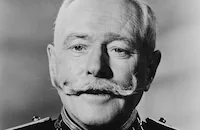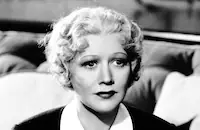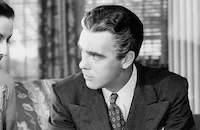Detective Story

Brief Synopsis
Cast & Crew
William Wyler
Kirk Douglas
Eleanor Parker
William Bendix
Cathy O'donnell
George Macready
Film Details
Technical Specs

Synopsis
Outside New York's busy 21st Precinct, police detective Jim McLeod spends a romantic moment with his devoted wife Mary, then escorts embezzler Arthur Kindred into the station. While booking Arthur, Jim tries to telephone Joy Carmichael, Arthur's childhood sweetheart, and informs her sister Susan about the young man's arrest. Jim then encounters Endicott Sims, a lawyer representing Karl Schneider, a New Jersey baby broker wanted on murder charges. Sims has just informed Jim's lieutenant, Monahan, that Schneider wants to turn himself in without incident and warns Jim not to touch his client. The volatile Jim openly expresses his hatred of Schneider, accusing him of murdering young girls. Jim's hard-drinking partner, Lou Brody, questions Arthur alone, and seeing his own dead son in the troubled war veteran, is sympathetic. Just then, two burglary suspects, Charley Gennini and Lewis Abbott, are brought in. With Lou's help, Jim interrogates both men and turns the slow-witted Lewis against Charley. After Jim promises to "go easy" on him if he cooperates, Lewis admits that the stolen loot is at Charley's place. To Arthur's chagrin, Susan then shows up at the station, worried and anxious. Arthur, who embezzled $480 in order to impress Joy, a successful model, tries to discourage Susan and sends her home. When Schneider arrives with Sims, Jim informs him that his baby broker "partner," Miss Hatch, has implicated him and will pick him out of a lineup. To Jim's disgust, Schneider has bribed Miss Hatch with a fur coat, and she refuses to identify him. Jim explodes and admits to reporter Joe Feinson that his hatred for his father, who drove his mother to an insane asylum with his unrelenting cruelty, has made him into a crusader against evil. Jim then decides to take Schneider to Bellevue Hospital, where a young victim of Schneider's "butchery" is being treated. On the way there, however, Jim learns that the woman has died, and without her identification, Jim has no case against Schneider. As they head back to the station, Jim threatens Schneider, who smugly declares that he has "friends in high places." Enraged, Jim slaps and punches Schneider until he collapses. Before leaving in an ambulance, Schneider tells Monahan that Jim is after him because of a man named Tami Giacoppetti. Although Jim denies knowing Giacoppetti, a racketeer, Monahan discreetly orders that both Giacoppetti and Mary be brought in. Meanwhile, Arthur's boss, Albert R. Pritchett, shows up to file charges against Arthur. While Pritchett questions Arthur about his motives, Susan returns and gives Pritchett $120 she scraped together. Calling Arthur a thief, Jim tries to dissuade Susan from helping him, but she pleads with Pritchett, swearing that the embezzled funds will be repaid. After Monahan sends Jim off on an errand, Lou steps in and all but convinces Pritchett to drop the charges. Mary then arrives and talks privately with Monahan. Monahan tells Mary, who has been trying to have a baby with Jim, about Jim's assault on Schneider and asks her about her past. At first, Mary denies knowing Giacoppetti and Schneider, but when Giacoppetti walks in and greets her, she runs out, crying. Unaware of what has just transpired, Jim returns and yells at Lou for interfering with Arthur, then orders Pritchett to press charges. Jim also rails against Charley, whose long rap sheet gives lie to his claims of innocence. Meanwhile, in his office, Monahan persuades Giacoppetti to reveal that years before, Mary became pregnant by him but, as he was married, decided to give the infant up. The baby was born dead at Schneider's "baby farm," and Giacoppetti never saw Mary again. Moments later, in front of Jim, a distraught Mary insists to Monahan that Jim knows nothing about her past. Confused, Monahan brings Mary and Jim into his office, where Mary confesses all to her husband. Once alone with Jim, Mary begs his forgiveness, but he calls her a tramp and asks if her infertility is the result of Schneider's handiwork. Stunned by Jim's harshness, Mary leaves in tears. Later, on the precinct rooftop, Lou approaches Jim and beseeches him to give Arthur a second chance, but Jim refuses. Joe then joins them and urges Jim to make amends with Mary while he still can. Jim finds Mary, who has come to the station to say goodbye, and pleads with her to stay. Mary relents, but after Sims makes a snide comment about Mary's love life, Jim admits to Mary that he cannot wash away the "dirty pictures" she has planted in his mind. Calling him cruel and vengeful like his father, Mary leaves Jim for good. Though numb with the knowledge that he has become the thing he most hates, Jim returns to booking Arthur. Just then, Charley, taking advantage of the station chaos, grabs a gun from a detective's holster and threatens to fire it. Fearlessly Jim advances on Charley, who shoots him repeatedly. After Charley is subdued, Jim asks Lou to release Arthur, then dies from his wounds. Lou frees Arthur, who walks out of the station with the faithful Susan by his side.

Director

William Wyler
Cast

Kirk Douglas

Eleanor Parker

William Bendix

Cathy O'donnell

George Macready
Horace Mcmahon

Gladys George

Joseph Wiseman

Lee Grant
Gerald Mohr
Frank Faylen
Craig Hill
Michael Strong
Luis Van Rooten
Bert Freed

Warner Anderson
Grandon Rhodes
William "bill" Phillips
Russell Evans
Edmund Cobb
Burt Mustin
James Maloney
Howard Joslin
Lee Miller
Mike Mahoney
Catherine Doucet
Ann Codee
Ralph Montgomery
Pat Flaherty
Jack Shea
Bob Scott
Harper Goff
Charles D. Campbell
Donald Kerr
Kay Wiley
Crew
Leon Becker
C. C. Coleman Jr.
John Cope
Farciot Edouart
Lee Garmes
Hugo Grenzbach
Edith Head
Earl Hedrick
Lester Koenig
Emile Kuri
Hal Pereira
Don Robb
John Shilling
Robert Swink
Wally Westmore
Robert Wyler
Robert Wyler
William Wyler
Philip Yordan

Videos
Movie Clip




Trailer
Film Details
Technical Specs

Award Nominations
Best Actress
Best Director
Best Supporting Actress
Best Writing, Screenplay
Articles
Detective Story
1951 saw the release of two of Kirk Douglas' finest performances, for Billy Wilder's Ace in the Hole and William Wyler's Detective Story. In Ace in the Hole Douglas deliberately pushed the limits of what audiences would accept in terms of an unsympathetic protagonist, which no doubt contributed to its ultimate failure at the box office. Thankfully, Ace in the Hole has since earned much overdue recognition as one of Billy Wilder's darkest and most uncompromising satires. In Detective Story, Douglas pursued a slightly different route with no less impressive results. Here the protagonist Jim McLeod starts out as a basically sympathetic, if troubled figure. As the film progresses, Douglas simultaneously reveals additional layers of psychological complexity and makes audience identification with him increasingly problematic. While the film's emotional power also depends on its taut direction, strong script--adapted from the Sidney Kingsley play--and vivid supporting cast, it is undeniably Kirk Douglas' performance that brings everything into focus.
Sidney Kingsley (1906-1995) was a member of the renowned Group Theatre, which included Lee Strasberg, Elia Kazan, Clifford Odets and Lee J. Cobb. His play Men in White (1934) won the Pulitzer Prize; other notable works by him include Dead End (1935), The Patriots (1943), and an adaptation of Arthur Koestler's Darkness at Noon (1951). Detective Story opened in New York in March of 1949 with Ralph Bellamy in the lead role, receiving largely positive notices and running for 581 performances. Paramount reportedly paid Kingsley $285,000 plus a share of the profits, making it one of the highest fees for a play up to that time. Kingsley, who had been pleased with Wyler's 1937 adaptation of Dead End, had Wyler in mind for the film version from the very beginning and even convinced Wyler to invest in the original Broadway production.
Kirk Douglas prepared for the role by accompanying actual police detectives on the beat and playing the part of McLeod for a week in a Phoenix-based production before shooting the film. Some of the play's original cast members reprised their roles for the film, including Lee Grant, Joseph Wiseman, Michael Strong and Horace McMahon. Wyler completed the shoot in an unusually quick 24 days--ahead of schedule. Not surprisingly, a number of changes had to be made to the play in order to placate Joseph Breen and the Production Code Administration. Breen's main objection was that Karl Schneider was an abortionist, something which the PCA would never have approved at that time. In the script as shot, Karl Schneider is supposedly a baby broker. However, the dialogue is deliberately ambiguous in places and it's likely that audiences would have understood that he was really supposed to be an abortionist. The Production Code also forbade the onscreen killing of law enforcement officials, but in this regard the PCA allowed an exception due to the moral thrust of the film.
William Wyler deserves credit for taking what is essentially a filmed play and turning it into surprisingly effective cinema thanks to his incisive mise-en-scene and his superb handling of actors. Sidney Kingsley even felt that Eleanor Parker's performance, which was nominated for a Best Actress Oscar®, was superior to that of the actress who originated the role on Broadway. Lee Grant received a Best Supporting Actress nomination for her reprisal of the shoplifter role. Sidney Kingsley stated afterwards that "the impact of the film is greater than the play [...] simply because Wyler and Paramount have been able to get wonderful characterizations out of the cast."
At the same time, the impact of Wyler's film does not just depend on the acting. While Detective Story remains essentially a filmed play, Wyler manages to use the inherent constraints of such an approach as an artistic advantage. The confined set of the police precinct is not simply a space where various characters observe each other and interact; it also contributes to the underlying thematic thrust and ultimately to the film's emotional power. The staging of the individual scenes, which often plays on foreground-background relationships, is also augmented by Lee Garmes' deep focus photography. (Wyler, of course, used deep focus photography extensively in the films he shot with Gregg Toland.) Detective Story is virtuoso filmmaking that catches the viewer off guard with its seemingly prosaic and unassuming surface. It, along with better known projects such as Dodsworth (1936), The Little Foxes (1941), Jezebel (1938) and The Heiress (1949), demonstrates why Wyler was practically unequaled in adapting plays for the screen.
Producer and Director: William Wyler
Script: Philip Yordan and Robert Wyler, based on the play by Sidney Kingsley
Photography: Lee Garmes
Art Direction: Hal Pereira and Earl Hedrick
Editor: Robert Swink
Costumes: Edith Head
Cast: Kirk Douglas (Jim McLeod), Eleanor Parker (Mary McCleod), William Bendix (Lou Brody), Cathy O'Donnell (Susan Carmichael), George Macready (Karl Schneider), Horace McMahon (Lieutenant Monaghan), Gladys George (Miss Hatch), Joseph Wiseman (Charley Gennini), Lee Grant (Shoplifter), Gerald Mohr (Tami Giacoppetti), Frank Faylen (Gallagher), Craig Hill (Arthur Kindred).
BW-103m.
by James Steffen

Detective Story
Quotes
Can't you say "Yes, sir" without makin' it sound like an insult?- Lieutenant Monaghan
Yes, sir.- Detective James McLeod
You're gettin' too superior, McLeod, a one-man army against crime. What's eatin' you?- Lieutenant Monaghan
I hate criminals. I don't believe in coddling them.- Detective James McLeod
I built my whole life on hating my father. All the time he was inside me, laughing.- Detective James McLeod
Trivia
Notes
The film's onscreen title card reads: "William Wyler's Production of Sidney Kingsley's Detective Story." According to a July 1949 New York Times news item, Paramount purchased Kingsley's play, which starred Ralph Bellamy on Broadway, for approximately $285,000, plus a percentage of the film's profits. The same item noted that this sale price was "the largest...since Columbia bought Born Yesterday in 1947." According to modern sources, Kingsley asked director Wyler, who had brought the playwright's hit Dead End to the screen in 1937 (see AFI Catalog of Feature Films, 1931-40), to invest $1,500 in the Broadway production of Detective Story, and wanted him to direct the film version. A December 1949 studio publicity item, contained in the file on the film at the AMPAS Library, announced that Dashiell Hammett had been assigned to write the screen adaptation. Modern sources claim that Wyler hired Hammett, who was being investigated by the House Committee on Un-American Activities (HUAC), as a favor, but that Hammett was unable to write. Hammett's contribution to the final film, if any, has not been determined.
The script for Detective Story encountered many problems with the Production Code Administration. In Kingsley's play, the "Karl Schneider" character is clearly identified as an abortionist and "Mary McLeod," his former patient. In a June 12, 1950 letter to Paramount executive Luigi Luraschi, PCA director Joseph I. Breen deemed an early draft of the screenplay "completely unacceptable...because of the element of abortion." Although Breen noted in a June 23, 1950 memo that Wyler appeared willing to substitute a disbarred baby broker for the abortionist, Wyler complained in a July 1950 New York Times article that the Code was "old fashioned" and that the PCA's refusal to allow any kind of discussion about abortion was "ludicrous." According to PCA files, Paramount threatened to appeal Breen's judgment to the MPPDA in New York, pointing out that the story clearly depicted abortion as evil. In a August 4, 1950 letter to MPPDA president Eric Johnston, Breen countered that the subject of abortion was "enormously dangerous to throw out for discussion before mixed audiences...especially the young and the adolescent" and should not be brought up at all. Although the final film does not contain the word "abortion" and Schneider's business is described as a baby brokerage, less overt references to abortion, such as calling Schneider a "butcher," remain in the film.
Breen stated in the June 12, 1950 letter that, in addition to abortion, the killing of "Jim McLeod" by "Charley Gennini" was a "violation of that portion of the Code which states that 'There must be no scenes at any time showing law-enforcing officers dying at the hands of criminals.'" Unlike the abortion issue, Breen had no personal objections to the depiction of Jim's murder, commenting in an November 8, 1950 letter to Luraschi that the while killing violated the letter of the Code, it was not in conflict with the spirit of the Code. Breen requested and apparently received special authorization to wave the no police killing rule.
According to news items, Paramount originally considered casting Alan Ladd in the role of Jim. Modern sources note that Kirk Douglas researched the part by working alongside detectives from New York's 47th Street Precinct for a few weeks and accompanying Los Angeles policemen on a ride-along. Douglas also prepared for his role by mounting and starring in a one-week production of Kingsley's play in Phoenix, AZ. Lee Grant, Joseph Wiseman, Michael Strong and Horace McMahon reprised their stage roles for the film. Grant made her screen debut in the picture and earned an Academy Award nomination as Best Supporting Actress for her portrayal of a marriage-hungry shoplifter. Because her then-husband, Alan Manoff, had been blacklisted and she refused to testify against him at the HUAC hearings, Grant had trouble finding additional screen roles and did not make another film until the 1956 release Storm Fear . Hollywood Reporter news items add Curtis Jarrett, Mary Castigliana, Hal Rand, Paul Palmer, Frank Orth and Betty Hall to the cast, but their appearance in the final film has not been confirmed. Detective Story marked the first time that actor Bob Evans [not the same as actor-turned-producer Robert Evans] appeared under the name Russell Evans.
According to a March 1951 New York Times article, Wyler rehearsed the actors for two weeks and filmed almost all of the picture on one large set on the Paramount lot. Modern sources note that Wyler, who was known for his long, elaborate shoots, completed principal photography ahead of schedule. No music score was written for the picture. Detective Story was both a critical and box office hit. Bosley Crowther of New York Times described the film as "brisk, absorbing," while the Daily Variety reviewer gushed that it "advances the cinema art form and at the same time packs a box office wallop." According to modern sources, Kingsley considered the film version of his story superior to the stage version. In addition to Grant's nomination, the film received Academy Award nominations for Best Actress (Eleanor Parker), Best Director and Best Writing (Screenplay). Douglas and Parker recreated their roles for a April 26, 1954 Lux Radio Theatre broadcast of the story.

Miscellaneous Notes
Released in United States Fall November 6, 1951
On December 19, 1949, Paramount announced that Dashiell Hammett originally had signed a contract to write the screenplay for "Detective Story".
Completed shooting March 24, 1951.
Released in United States Fall November 6, 1951














